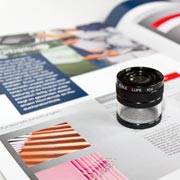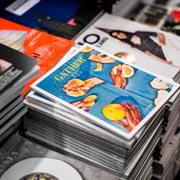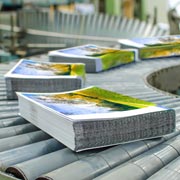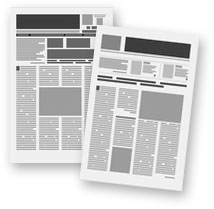Top Tips for Printing on a Budget
Leave a CommentSometimes a printed sales or marketing job simply needs to be as economical as possible. The quality still needs to be high but, for whatever reason, the production budget is particularly tight this time. For example, maybe you’re a start-up with limited budget, or two years of the pandemic have knocked your business for six. Or, perhaps you’re exhibiting at a trade show, already spent most of your budget on the space and stand, and forgot to order printed marketing materials to hand out to prospects. Well, worry not — there are always ways to save money when buying print on a budget. Take a look …
for whatever reason, the production budget is particularly tight this time. For example, maybe you’re a start-up with limited budget, or two years of the pandemic have knocked your business for six. Or, perhaps you’re exhibiting at a trade show, already spent most of your budget on the space and stand, and forgot to order printed marketing materials to hand out to prospects. Well, worry not — there are always ways to save money when buying print on a budget. Take a look …
Go Thinner
Have a think about the thickness of your paper or card. Does it really need to be that thick? Dropping from, say, 170gsm to 150gsm, 135gsm or even less will save you money and that saving could amount to a significant one, especially if you are producing a large print volume.
Posting Your Print?
If your printing is going to be posted, its thickness, size and weight are even doubly important. It would be tragic if your printed item was just a fraction over Royal Mail’s size and weight threshold, forcing you into the next price band. For example, if your printed piece is too large for standard First Class mail and sneaks into the ‘Large Letter’ band, sending just 500 out to prospects will cost you around £220 more in postage than it would otherwise have done. That’s not even allowing for additional costs like larger envelopes. So, some careful pre-planning of size, shape and paper weight can save significant money on postage when you get it right.
Ditch the Fancy Finishes
 Do you really need that lamination? Or the rounded corners? Or the integral pocket for inserts? Eliminating luxuries at a time of need will save you money, for sure. It’ll also speed up production and that might also be critical if this print job has been left to the last minute.
Do you really need that lamination? Or the rounded corners? Or the integral pocket for inserts? Eliminating luxuries at a time of need will save you money, for sure. It’ll also speed up production and that might also be critical if this print job has been left to the last minute.
Paper Finishes
Textured paper will almost always be more expensive than untextured. So, if you’re on a budget, forget laid paper, watercolour paper textures, onion skin textured paper and the like — it’s likely to add a significant amount to production costs. So, keep it simple when budgets are slim.
Going a step further, there is even a huge variety of untextured papers. Trendy uncoated (or ‘offset’) papers look organic and fresh, but they’re likely to cost quite a bit more money than more standard coated papers, which are produced in higher volumes at paper mills. In other words, the more ‘run-of-the-mill’ papers will help to save you money.
Branded vs. Unbranded
Do you really need to use that paper brand? There really are some lovely branded papers and cards out there, but when budgets are tight, any good commercial printer will be able to steer you towards a non-branded stock that could be a fraction of the price, but look every bit as good as the big brands.
Size & Format Considerations
 Keep an eye on paper size/format to avoid paper wastage. What do we mean? Well, printing based on ‘A’ sizes (A4 and A5 etc.) will generally be cheaper to produce than bespoke sizes. That’s because there is less wasted paper/card produced when printers use the most commonly available paper sizes. So, perhaps that square brochure is not such a good idea if you are on a tight printing budget.
Keep an eye on paper size/format to avoid paper wastage. What do we mean? Well, printing based on ‘A’ sizes (A4 and A5 etc.) will generally be cheaper to produce than bespoke sizes. That’s because there is less wasted paper/card produced when printers use the most commonly available paper sizes. So, perhaps that square brochure is not such a good idea if you are on a tight printing budget.
Brochure Binding
If your brochure or catalogue needs to be bound because it’s multi-page, consider the binding mechanism carefully. A folded brochure (e.g. 4 pager, multi-page ‘roll’ fold or even a ‘map’ fold) will generally be cheaper to produce than something that needs a separate binding stage. Even saddle-stitching (essentially stapling) will save money compared to wiro binding, velo binding, perfect binding and so on.
Ganging up
 ‘Ganging up’ is a great way to save money on print. The term refers to printing several jobs at the same time, on the same sheet. In this way, less printing passes (and, in the old days, less printing plates) are required because jobs are printed simultaneously. Once the large, multi-job, sheet is printed, it can then be cut down into it’s separate elements. An example would be A4 four-page brochures being produced at the same time as, say, A4 and/or A5 leaflets, all printed simultaneously on an SRA2 or SRA1 sheet. Some simple mathematics will be required to work out how many copies are produced of each, but ganging up certainly saves money when the maths and volumes work out nicely.
‘Ganging up’ is a great way to save money on print. The term refers to printing several jobs at the same time, on the same sheet. In this way, less printing passes (and, in the old days, less printing plates) are required because jobs are printed simultaneously. Once the large, multi-job, sheet is printed, it can then be cut down into it’s separate elements. An example would be A4 four-page brochures being produced at the same time as, say, A4 and/or A5 leaflets, all printed simultaneously on an SRA2 or SRA1 sheet. Some simple mathematics will be required to work out how many copies are produced of each, but ganging up certainly saves money when the maths and volumes work out nicely.
Top tip: Ask us for advice!
Photography & Illustration
If your brochure, leaflet or mini-catalogue requires photography or illustrations, there are potential ways to save money there too. Decent photographers and illustrators are expensive, to be frank. However, there are many ‘royalty-free’ image libraries that can offer high quality stock photos and illustrations for just a few pounds each. Adobe Stock, for example. They have literally millions of photos and images to choose from and you can even pay-as-you-go rather than having to sign up for anything long term.
Perhaps you need bespoke product/pack shots, though? These days, with ‘photo light tent’ kits available for less than £100 online and handheld mobile phones offering ample sharpness and resolution, it’s possible to get professional-looking pack shots produced entirely on a D.I.Y. basis. All on a low budget.
Print Management
Professional print management should also save you money. If someone like Southside Print manages all your print, for the entire year, then savings can be made. That’s through a combination of things like ganging up, using print-on-demand so nothing goes to waste, and delivering several jobs at the same time to save on delivery costs. Going local also helps with delivery (if you’re in or near to the London SE1 area, our printing services are close by).
Multi-use & Reusable Print
Make your print multi-use. For example, perhaps you have a mini catalogue as well as a brochure. Well, combining the two into one printed document could save you money on production.
Similarly, making your printing reusable will also mean you don’t have to keep reprinting. For example, display graphics, laminated print collateral and banners can all be reused. Storing carefully will also extend their shelf lives.
Choose Your Printer Carefully
 Choose your printer carefully. With Southside Print you will come to know that we are always competitively priced. What’s more, even when we print on a budget, our printing quality is superb and it’s also fast. Take a look at our 5 star Trust Pilot reviews and 5 star Google reviews and you’ll soon see this for yourself.
Choose your printer carefully. With Southside Print you will come to know that we are always competitively priced. What’s more, even when we print on a budget, our printing quality is superb and it’s also fast. Take a look at our 5 star Trust Pilot reviews and 5 star Google reviews and you’ll soon see this for yourself.
DIY Design & Artwork
If you know what you are doing, have a good eye for design and have the right (professional) software, you could consider producing your design and artwork entirely in-house. That’ll save you from spending out on professional design externally. However, it’s a tricky one because a poorly executed design can be a false economy. If the look, design and feel of your printed piece looks poorly executed, unattractive and confusing in terms of communicating your sales or marketing proposition, then it doesn’t matter how well it’s printed or how cheap it was to produce. Indeed, it could end up being a waste of time and money if the design and messaging is wrong. So, we suggest that the design of your printed piece is perhaps one area that you should not scrimp on even when budgets are tight. That’s unless, of course, you can ensure it’s going to look professional, clear in terms of message and technically correct using any in-house capabilities. If not, Southside Print offers a professional design and artwork service and we’re here if you need us.
It’s all a Balance
It’s all a balance, of course. You don’t want your sales and marketing collateral to do your product or service a disservice, so exactly where and how you save money needs careful consideration.
Competitively-Priced, High Quality Printers & Designers in London SE1
Southside Print can help with advice, of course, and our advice is totally free. We are a digital printer, large format printer and offer a complete range of print-related services near London Bridge. Print and design quotations are also free so, if you would like to request a free quote, have any questions or need advice, please get in contact and we’ll be happy to help.


 Newsletter Sizes & Formats
Newsletter Sizes & Formats